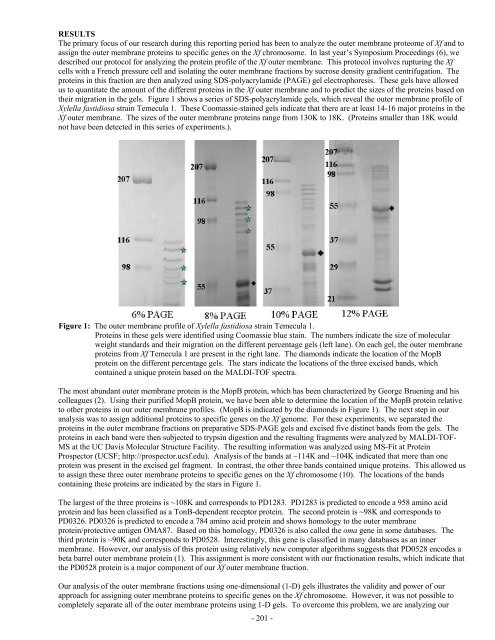Impact Of Host Plant Xylem Fluid On Xylella Fastidiosa Multiplication ...
Impact Of Host Plant Xylem Fluid On Xylella Fastidiosa Multiplication ...
Impact Of Host Plant Xylem Fluid On Xylella Fastidiosa Multiplication ...
You also want an ePaper? Increase the reach of your titles
YUMPU automatically turns print PDFs into web optimized ePapers that Google loves.
RESULTS<br />
The primary focus of our research during this reporting period has been to analyze the outer membrane proteome of Xf and to<br />
assign the outer membrane proteins to specific genes on the Xf chromosome. In last year’s Symposium Proceedings (6), we<br />
described our protocol for analyzing the protein profile of the Xf outer membrane. This protocol involves rupturing the Xf<br />
cells with a French pressure cell and isolating the outer membrane fractions by sucrose density gradient centrifugation. The<br />
proteins in this fraction are then analyzed using SDS-polyacrylamide (PAGE) gel electrophoresis. These gels have allowed<br />
us to quantitate the amount of the different proteins in the Xf outer membrane and to predict the sizes of the proteins based on<br />
their migration in the gels. Figure 1 shows a series of SDS-polyacrylamide gels, which reveal the outer membrane profile of<br />
<strong>Xylella</strong> fastidiosa strain Temecula 1. These Coomassie-stained gels indicate that there are at least 14-16 major proteins in the<br />
Xf outer membrane. The sizes of the outer membrane proteins range from 130K to 18K. (Proteins smaller than 18K would<br />
not have been detected in this series of experiments.).<br />
Figure 1: The outer membrane profile of <strong>Xylella</strong> fastidiosa strain Temecula 1.<br />
Proteins in these gels were identified using Coomassie blue stain. The numbers indicate the size of molecular<br />
weight standards and their migration on the different percentage gels (left lane). <strong>On</strong> each gel, the outer membrane<br />
proteins from Xf Temecula 1 are present in the right lane. The diamonds indicate the location of the MopB<br />
protein on the different percentage gels. The stars indicate the locations of the three excised bands, which<br />
contained a unique protein based on the MALDI-TOF spectra.<br />
The most abundant outer membrane protein is the MopB protein, which has been characterized by George Bruening and his<br />
colleagues (2). Using their purified MopB protein, we have been able to determine the location of the MopB protein relative<br />
to other proteins in our outer membrane profiles. (MopB is indicated by the diamonds in Figure 1). The next step in our<br />
analysis was to assign additional proteins to specific genes on the Xf genome. For these experiments, we separated the<br />
proteins in the outer membrane fractions on preparative SDS-PAGE gels and excised five distinct bands from the gels. The<br />
proteins in each band were then subjected to trypsin digestion and the resulting fragments were analyzed by MALDI-TOF-<br />
MS at the UC Davis Molecular Structure Facility. The resulting information was analyzed using MS-Fit at Protein<br />
Prospector (UCSF; http://prospector.ucsf.edu). Analysis of the bands at ~114K and ~104K indicated that more than one<br />
protein was present in the excised gel fragment. In contrast, the other three bands contained unique proteins. This allowed us<br />
to assign these three outer membrane proteins to specific genes on the Xf chromosome (10). The locations of the bands<br />
containing these proteins are indicated by the stars in Figure 1.<br />
The largest of the three proteins is ~108K and corresponds to PD1283. PD1283 is predicted to encode a 958 amino acid<br />
protein and has been classified as a TonB-dependent receptor protein. The second protein is ~98K and corresponds to<br />
PD0326. PD0326 is predicted to encode a 784 amino acid protein and shows homology to the outer membrane<br />
protein/protective antigen OMA87. Based on this homology, PD0326 is also called the oma gene in some databases. The<br />
third protein is ~90K and corresponds to PD0528. Interestingly, this gene is classified in many databases as an inner<br />
membrane. However, our analysis of this protein using relatively new computer algorithms suggests that PD0528 encodes a<br />
beta barrel outer membrane protein (1). This assignment is more consistent with our fractionation results, which indicate that<br />
the PD0528 protein is a major component of our Xf outer membrane fraction.<br />
Our analysis of the outer membrane fractions using one-dimensional (1-D) gels illustrates the validity and power of our<br />
approach for assigning outer membrane proteins to specific genes on the Xf chromosome. However, it was not possible to<br />
completely separate all of the outer membrane proteins using 1-D gels. To overcome this problem, we are analyzing our<br />
- 201 -











